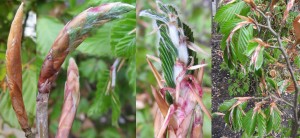Budburst is the emergence of new leaves on plants, which signals the beginning of a new growing season cycle. (GLOBE)
Budburst is one of the more commonly recorded phenophases, many organisations and phenological networks carrying out recording for this seasonal event, including: Project Budburst, Nature’s Calendar, USANPN, Beagle Project and GLOBE.
One reason there is such emphasis on recording the phenological timing of budburst, is that it is often considered to signal the start of the growing season. Budburst is usually easily identified (especially for plants within temperate regions) making it a valuable phenophase for recording (see GLOBE).
Defining the exact point of budburst for recording differs between each of the recording networks. It is crucial that those collecting recordings for a given network fully understand the budburst protocol followed by that network. To define budburst for the UoRPMN, the methods of recording used for each of the major budburst recording networks were first considered. The aim was to produce a recording method that would be consistent in providing results that could be input into as many of the more wide scale phenological networks as possible.
Budburst Protocol
The majority of recording networks define budburst as the point at which the colour of the new leaves are visible through openings on the swollen bud (Beagle Project). This provides a quick, easy identification of the timing of budburst; this is crucial for networks which rely on volunteers for recording.
Although UoRPMN will eventually rely heavily on citizen input (like many phenological networks), it was decided that unlike the recording protocol followed by most networks to record presence/absence of budburst, UoRPMN would follow a rank score, similar to the BBCH scale.
BBCH scale
The BBCH scale is a system for uniform coding of phenologically similar growth stages of all mono- and dicotyledonous plant species (Meier, 2003). It divides the growth stages of a plant into 10 principlal growth stages; starting with germination/bud development through until senescence and/or the beginning of dormancy.
UoRPMN Budburst – recording protocol
The BBCH principal growth stage scale was used as a basis to develop a rank score method for budburst recording for the UoRPMN. It was decided that budburst would be subdivided into 4 stages of development:
Stage 0 – Dormant
Stage 1 – Bud Swelling
Bud swelling can occur both laterally (giving the impression of the bud appearing swollen and plumper) and through elongation (bud appears stretched).
Stage 2 – Green Showing
This is the stage recorded by most networks as budburst; when the colour of the new leaves are visible through openings in the swollen bud (e.g. Nature’s Calendar).
Stage 3 – Leaf Extended
When at least three leaves per stem are extended, at three separate locations on the plant.
Stage 4 – Leaf Fully Exposed
When at least three leaves per stem are fully exposed, at three separate locations on the plant.
Reference:
Beagle Project http://www.beagleproject.org/pdf/phenophases.pdf
GLOBE http://gpdi.globe.gov/trainingmaterials.htm
Meier, U (2003). Phenology: An Integrative Environmental Science. Phenological Growth Stages, p.p. 269-283.. Netherlands: Kluwer Academic Publishers.
Nature’s Calendar http://www.naturescalendar.org.uk/survey/events/budburst.htm

